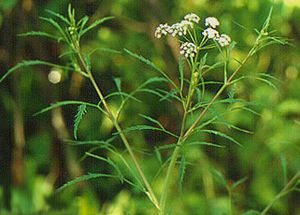Bulb-bearing water-hemlock facts for kids
Quick facts for kids Bulb-bearing water-hemlock |
|
|---|---|
 |
|
| Conservation status | |
| Scientific classification | |
| Genus: |
Cicuta
|
| Species: |
bulbifera
|
Cicuta bulbifera, often called the bulb-bearing water-hemlock, is a plant that grows naturally in North America. It belongs to the Cicuta group, which includes four types of plants that are all very poisonous. This plant gets its name from the tiny, round structures called bulbils. These bulbils look like small bulbs and grow where the leaves meet the stem, especially on the upper parts of the plant. You can tell Cicuta bulbifera apart from other water-hemlocks, like Cicuta douglasii, because its leaf parts are very narrow (less than 1/4 of an inch wide) and it has these special bulbils.
What Does it Look Like?
This plant is a perennial, meaning it lives for more than two years. It can grow to be about 1.5 to 3.5 feet (45 to 105 cm) tall. Its stems are light green, sometimes a bit reddish, and feel smooth. They also have a slightly waxy coating that makes them look a bit dull or bluish-green.
The leaves grow in an alternating pattern along the stem. They are green and also have that waxy coating, except for their stalks. Lower leaves can be quite large, up to 1 foot (30 cm) long and 0.5 feet (15 cm) wide. They get smaller as they go up the stem. The lower leaves are made of many smaller leaflets arranged in a complex way, while the upper leaves are simpler.
The small leaflets are about 3 inches (7.5 cm) long and 0.33 inches (0.8 cm) wide. They are long and narrow, with jagged edges. Sometimes, they are even split into thinner parts. A key feature is that the upper leaves often have small, egg-shaped bulbils where they join the stem. These bulbils can drop off and grow into new plants. The plant's roots are thick and fleshy, growing in a cluster.
The stems end in clusters of small white flowers. Each cluster is about 2 to 4 inches (5 to 10 cm) wide and looks like an umbrella. These large clusters are made up of about 8 smaller umbrella-like groups, and each of those has about 16 tiny flowers. The flowers themselves are very small, about 1/8 inch (3 mm) across. Each flower has 5 white petals, 5 stamens (which make pollen), and an ovary (which holds the seeds).
This plant blooms in late summer to early fall, and its flowers last for about a month. They don't have a strong smell. After the flowers, small, flattened, egg-shaped fruits form. Each fruit contains one seed.
Where Does it Grow?
Cicuta bulbifera is native to North America. You can find it across a wide area, from Newfoundland and Labrador in Canada all the way to British Columbia. In the United States, it grows in states like Virginia, Indiana, Nebraska, and Oregon.
Since it's a perennial plant, it can reproduce in two ways: by its seeds and by those special bulbils. It likes to grow in very wet places. You'll often find it along the edges of marshes and lakes, in bogs, and in wet meadows. It can also grow in shallow standing water or next to slow-moving streams. Sometimes, it even grows on small mounds of earth, on rotting logs that are partly underwater, or even on beaver dams! This plant usually grows in very healthy wetland areas.
Why is it Dangerous?
It's very important to know that all parts of the Cicuta bulbifera plant are highly poisonous to both humans and animals. The thick roots, the base of the stem, and the young shoots are especially toxic. Animals, like livestock, are most often poisoned in dry areas of the western United States. This happens when they go to low, wet spots to find green plants to eat during dry periods.
The poisonous substances in Cicuta bulbifera are similar to those found in other plants of the Cicuta genus. The roots are the most poisonous part, but all parts of the plant can contain some poison, especially when the plant is young. Eating even a small piece of the root can be very dangerous for an adult. Some experts consider these plants to be among the most poisonous leafy plants found naturally in North America.
People have been poisoned by these plants many times. Children and adults have sometimes eaten the roots by mistake, thinking they were edible plants like parsnips. This can lead to serious health problems. Most cases of poisoning happen in early spring. The amount of Cicuta bulbifera needed to cause harm depends on the season and how old the plant is. For example, a piece of root about the size of a walnut is enough to cause serious harm to a cow.



